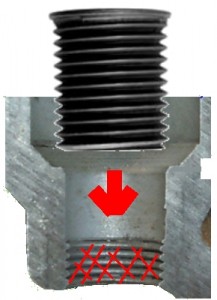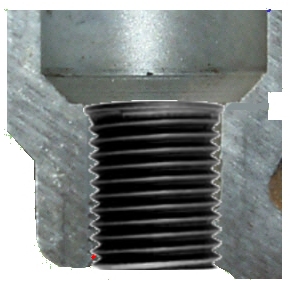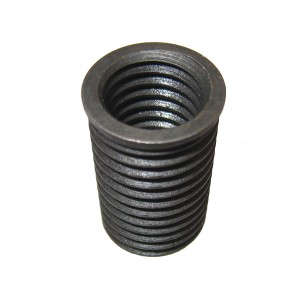Ok, so I know I have a blown spark plug. I found the ignition coil and plug rolling around on top of the head, instead of in the plug well where they belong. It’s pretty obvious what the problem is. The next question is, what do I do to fix it.
Doing a bit of web searching for blow spark plug or spark plug repair will turn up more hits than you can count, for many different engines. This problem is clearly not just a Ford Triton problem.
Ok, so it’s a common enough problem, but what do you do to fix it. Looking at what others have done it looks like solutions range from replacing the entire engine to just screwing the plug back in, and everything in between. People have reported replacing engines at a cost for the Triton 5.4 and 6.8 for anywhere between $6,000 and $12,000. Ok that’s clearly out. That’s going to be more than I paid for the entire truck, there’s no way I’m paying that kind of money for a repair. And there’s no reason I can see that this requires a new engine.
Next, new heads. It sounds like if you go to Ford they are going to suggest new heads. Replacing the heads means lifting the cab off the frame, stripping all the top end plumbing, new fluids, etc. Reports are $2,000 to $4,000 for head replacement. And it’s not clear that you get a solution any better than what you started with. Four threads in an aluminum head. It might hold until the next time you replace the plugs, or it might not. I’m not really interested in spending that kind of money to replace a weak head with another copy of the same weak head.
New engine and new heads are out for me. Too much money and both sound like overkill. The next solution is a threaded insert. First off, what is a threaded insert? Time to check wikipedia. A threaded insert is a threaded cylinder often placed in a softer base material to provide new or stronger threads for a fastener to thread into.
Here’s a picture of a typical threaded insert:
Inserts come in a variety of sizes and shapes but they all have the feature of some way to screw / glue / press fit / or somehow otherwise afix themselves into a hole in the base material or the material being repaired, and provide an inner threaded hole for the new fastener to screw into. In my case the outside of the insert needs to attach itself to the spark plug hole in the head and provide new threads for the spark plug to screw into.
Looking back at the cross section of the cylinder head cut through the plug hole, assume you’ve just blow a spark plug. Assume all of the threads have been ripped out of the plug hole and you’re left with essentially a smooth hole top to bottom with nothing for the spark plug to screw into.
The basic idea is to get the threaded insert fixed into the spark plug hole resulting new threads for the spark plug to screw into.

|

|
Ok, so that’s what a threaded insert is, but are they any good. Is a threaded insert a good fix? And what’s it going to cost to put one in? This is where things get complicated. There are many many options for threaded inserts, different materials, different sizes, different ways to fix them in the hole. The question is which solution is best, and what’s it going to cost. Searching the web for Triton, or V10, or 6.8L, spark plug repair, then filtering out the broken plug problem in the 05’s and later, and the solutions narrow down to just a handful. It turns out this is a common enough problem you can stop by your local auto parts store and buy a cheap spark plug thread insert kit for $40 to $60 bucks. You can also get mid range insert kits for in the $130 to $200 range, and then you can get the “high end” kits for around $400. Ok, so what gives, why the huge range in prices, 10 to 1 from the cheap auto parts kit to a high end kit. At this point you’re going to have to rely on a lot of anecdotal evidence, people’s opinions, and marketing literature.
Opinions vary widely on the reliability of using thread inserts but the majority seem to lean toward “a good insert is a good fix” and “a bad insert is no fix at all”.
Ok, so it sounds like a “good” insert is a reasonable, reliable, fix. Now what is that going to cost. Again, searching the web reveals people quoting hundreds to thousands to get an insert put into a head. It looks like there are two schools of thought, the “remove the head and do it right” school, and the “do it over the fender with the heads in place” school. What this means is option 1, removing the heads, is going to cost an arm and a leg. Getting the heads off of the Triton V10 is a labor intensive job, that means expensive. I understand that having the heads off allows you to see exactly what you are doing, where the tap is, how deep the insert goes. With the heads off you can insure clearance between the tools and the valves, but it’s expensive. I’d like to avoid expensive. The “do it over the fender” route is the cheapest, as long as nothing goes wrong. But even if something does go wrong it’s probably not that much more expensive than going the “remove the heads” route in the first place. So now I’m headed down the “do it over the fender” threaded insert path. So what does that cost. It looks like you can get a “trained” mechanic to do an over the fender thread insert for anywhere from around $500 to nearly $1000 for the first insert and something less for the second and third insert if other plug holes need inserts at the same time. Five hundred to a thousand bucks is still not cheap for a single plug hole repair.
How about if I do it myself. Now I’m down to the cost of the insert kit and my time. Starting at the low end, with the cheap kits, the heli-coils and other spring like thread insert variants. The heli-coil style inserts are pretty much universally panned. The opinions seem to be that heli-coils in a spark plug hole are a waste of time, it will come out again. So that’s no good for me. I may be cheap but I don’t want to do this job again.
As you start to narrow down the kits a few big names start to stand out, Timesert seems to be by far the most popular and most recommended. After Timesert you hear less often about the Cal-Van Tools kit, Lisle Spark Plug Rethreading tool for Ford – 65900 kit, and a small handful of others. All three of these “high end” kits work by the same principle, drill out the existing spark plug hole to make room for the new insert, tap the new hole for the insert to thread into, and then “lock” the insert into place one way or another.
The Lisle immediately turned me off by requiring the top of the insert be deformed with hammer blows from above after the insert is screwed into place. You drill out the spark plug hole, thread it, put in the insert, then drop a cone shaped tool on top of the insert and beat on it with a hammer to expand the top of the insert and lock it into the head. Something about that just sits wrong with me. It looks like people have used the Lisle solution and are happy. I think I’ll pass.
The Cal-Van kit gets some nice reviews. Apparently the Cal-Van kit is what Snapon sells for thread repair, Snapon – Set, Spark Plug Insert Installer, Ford. So if it’s good enough for Snapon it ought to be good enough for me right? Yeah, not so much. I’m not a tool fanboy. I like high quality tools but just because it has someone’s name on it doesn’t mean it’s a good tool. I like to research my tools and make my own decisions. Looking at the Cal-Van it has one trick I really like, but one another trick that makes it a show stopper for me. I’ll talk about the bad first so I can explain why I ruled out the Cal-Van. The Cal-Van insert is touted as one of the largest inserts you can buy. By largest I mean the outside diameter. The inside diameter of all of the inserts has to be the same size, the size of the spark plug. The outside diameter can vary depending on the size of the hole drilled in the head. The advantage to a mechanic of using the Cal-Van insert is that it is so big that the hole drilled in the head will hide all previous evils. That is, if an attempt has been made previously to repair the spark plug hole with a smaller insert the Cal-Van insert is so big you just drill out everything, wider and bigger than any insert that has come before. The Cal-Van is the final solution. Great big hole, drill away all that have come before. This sounds good if you’re a mechanic on the clock. You don’t want to mess around finding the right size insert depending on if this plug hole has been repaired before or not. Just drill it out to the maximum size and put in the insert. This might sound good but it’s a non starter for me. I’m more a take just enough off to do the job right, and no more, kind if a guy. Given that the Cal-Van is final solution, and I’m not quite ready for a final solution, I decided to pass on the Cal-Van. Cal-Van does have a neat trick for determining if the valves are closed before attempting the repair. I ended up buying that piece of their kit but I’ll talk about that later.
That brings me to the Timesert kit. Timesert makes a couple kits to repair Triton plug blowouts, the 4412E and the 5553. At this time the 4412E costs around $200 plus the cost of the inserts and the 5553 costs around $400, is a bigger kit, and comes with 5 inserts. Timesert also sells a 4412 kit, without the E on the end. If you are working on a Ford Triton you want the 4412E kit, not the standard 4412. The E stands for Extended, as in longer tools. The Triton spark plug wells are nearly 6 inches deep. You need the extended tools to reach.
In my next post I’ll talk more about the Timesert kits and which kit I purchased.

